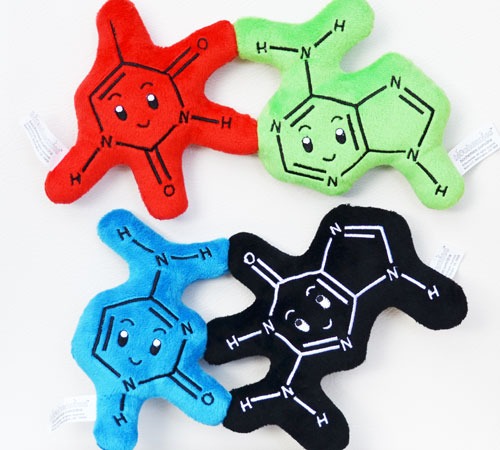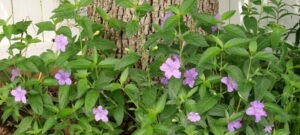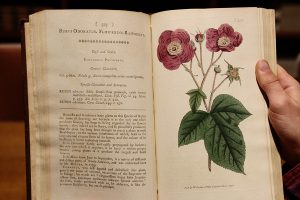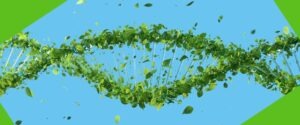Article originally published in The Leaflet (April 2014) by Brian Witte, PhD, BRIT Research Associate
(Disclaimer: The technical aspects of this article are dramatically simplified in the interests of communicating with an audience entirely unfamiliar with molecular biology. Send me an email (bwitte@brit.org) if you would like a deeper explanation.)
We like to repeat, loudly and often, that there are over 1 million plant specimens in the Philecology Herbarium at BRIT. It’s a nice, big, round number, and it sounds cool when tour groups come through. What if I told you that as imposing as that number sounds, the real number is closer to a thousand billion (1,000,000,000,000) plants*?
The goal of a herbarium is to preserve plants. The ideal specimen, in many respects, has all the essential elements used in identification: leaves, stems, roots, flowers, and fruit. The characteristics actually used in distinguishing one species from another will vary from group to group. Among the pea-family (Fabaceae) plants I am studying, for example, minute hairs on the leaf surfaces are a key feature in distinguishing among species in the genus Astragalus. Some species have hairs that attach at the base (just as human hairs appear to do). Other species have hairs that attach at a mid-point, so that each hair has two ends pointing out into space. Another key characteristic in Astragalus is the shape, size, and texture of the seed pods: inflated or constricted, linear or scimitar-shaped, stalked or attached directly to the flower base. With ~150 species of Astragalus just in the state of New Mexico (where my samples originate), it is nearly impossible to make a determination of an unknown Astragalus if no seed pods were collected.
We have known for decades now that there is a better way of distinguishing among species. Each plant, after all, carries a set of instructions that dictate the shapes we see in the leaves, flowers, and fruits. Reading those instructions is still a challenge and is very much an imperfect process, but this process has opened doors into whole new ways of understanding how living things are related and which differences are significant enough to be worth naming.
Those instructions, as you’ve probably guessed, are carried in DNA – short for Deoxy ribo-Nucleic Acid. DNA comes in 4 “flavors,” abbreviated as A, G, C, or T. Each “flavor,” or “base” as we call them in molecular biology, is made of the same carbon, oxygen, and nitrogen atoms. Each letter, though, represents a unique arrangement of those atoms. A full molecule of DNA is made of a row of bases, each joined to its neighbors at the shoulder. The machinery in the cell, or the machinery in a science lab, can tell the difference among the four unique patterns, and thus “read” DNA. When we talk about sequencing DNA, we mean that a DNA molecule was fed into a machine that was able to read it from one end to the other. A sample output might look like: AGGCCATTACGT…

Nearly every cell of every living thing has a long chain of DNA at its center. The machinery of the cell reads that chain, and more molecular machines are made according to its specifications. As these tiny machines interact, they build the cells of the plant. As the cells interact, they make the leaves, or roots, or stems. When organisms change, or evolve, the change happens because the children of an organism received a slightly different sequence of A’s, C’s, G’s and T’s than their parents possessed. Sometimes a change of one base is enough to radically alter an organism – just one base different among the billions of bases that make up the DNA in a single cell. More often, a change in the appearance of an organism requires many changes to the DNA. By comparing the DNA sequence from two samples, a scientist can estimate how closely related they are. The fewer changes in the DNA sequence from one organism to another, the more recently they shared a parent.
The beauty of this technique is that you do not need a perfect specimen to make an identification of a plant. All you need is a single leaf or a portion of a leaf. Every cell of every plant in the herbarium contains the instructions to make a whole, new plant. (This is why I used that plants* designation in the opening paragraph. That’s because the herbarium contains the instructions for building a thousand billion [10^12 or 1,000,000,000,000] plants – one copy per plant cell.)
There are problems and difficulties, of course. The DNA molecules are fragile (each is a string one atom wide and ~10 billion atoms long, after all), and heat or moisture or decomposition can damage them. Removing the DNA from the surrounding tissues takes time, money, and specialized equipment. Reading the DNA you isolate from a sample requires a machine that costs tens of thousands of dollars, and the information has to be analyzed using computers and the brains of scientists who have trained for years. The miracle is that it’s even possible at all, even though the costs are decreasing every year, and the process becomes simpler as new tools are developed.

A bank of DNA sequencers (Wikipedia.com)
The result is that new frontiers of science are being explored…sometimes using plant specimens collected a hundred years before anyone had even guessed at the existence of DNA. The oldest specimen at BRIT was glued to a sheet of paper nearly 100 years before Gregor Mendel, working in the 1860s, figured out the rules of heritability. Now that DNA technology is relatively easy to use, scientists are literally rewriting the book of life, discovering new species and realigning the evolutionary trees worked out by generations of scientists working only with morphological information. Many of these advances are only possible because of the vast wealth collected over hundreds of years and stored in natural history collections, and herbaria in particular. Many species have gone extinct, many habitats have been lost entirely to urbanization and agriculture, and plants species have begun interbreeding with non-native invaders introduced by humans. Even with an unlimited budget for field work, some plant samples are available ONLY from herbaria. In the real world, with very limited budgets for basic science, herbaria are irreplaceable stores of information that these new tools can bring to light.






